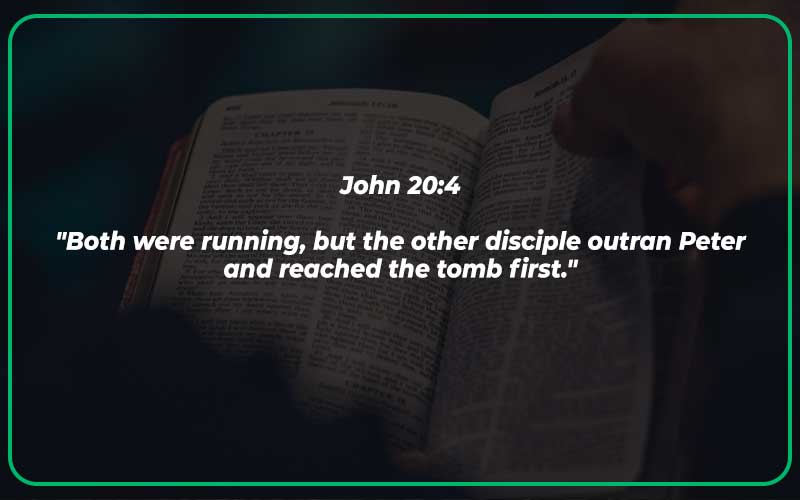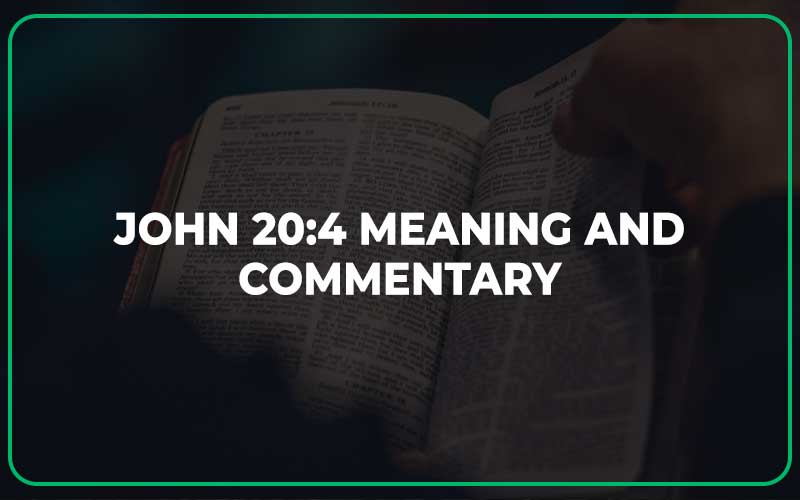John 20:4
“Both were running, but the other disciple outran Peter and reached the tomb first.”
John 20:4 Meaning
In John 20:4, the verse describes the events immediately after Jesus’ resurrection. It highlights the moment when Peter and John, two of Jesus’ disciples, raced to the tomb after Mary Magdalene had reported that it was empty. The verse gives us insight into the competitive nature of Peter and John as they both run to verify Mary’s claims.
John 20:4 Commentary and Explanation
In John 20:4, we encounter a poignant moment in the Gospel narrative, where the disciples are racing to the empty tomb after Mary Magdalene’s startling announcement that she has seen the Lord. This verse reads: “So they ran together, and the other disciple outran Peter and came to the tomb first.”
The urgency and excitement in this verse are palpable. The use of the word “ran” conveys their eagerness to confirm Mary’s revelation. We are presented with two prominent figures in this race: “the other disciple” and Peter. We believe that”the other disciple” refers to John himself, the author of this Gospel.
It’s noteworthy that John emphasizes the swiftness of the race by specifying that he outran Peter. This detail is not merely about physical agility but carries symbolic meaning. It highlights the fervor of John’s faith and love for Jesus, and this echoes themes that John emphasizes throughout his Gospel, such as the “beloved disciple” who reclined next to Jesus at the Last Supper.
To fully appreciate the significance of this moment, we can cross-reference it with other passages in the Bible. For example, in Luke 24:12, we find another account of Peter rushing to the tomb. The fact that both Peter and John hurried to the tomb underscores the importance of the resurrection event, as well as their devotion to Jesus.
Furthermore, this verse reminds us of the spiritual race we all run as Christians. In 1 Corinthians 9:24-25, the apostle Paul uses the metaphor of a race to encourage believers to live faithfully: “Do you not know that in a race all the runners run, but only one receives the prize? So run that you may obtain it. Every athlete exercises self-control in all things.”
In our Christian journey, just like in this race to the tomb, there is a need for enthusiasm, determination, and a desire to reach the destination quickly. We should strive to outpace our doubts, fears, and distractions in pursuit of the resurrected Christ.
John 20:4 captures the fervent response of the disciples to Mary Magdalene’s proclamation of the empty tomb. John’s emphasis on his own swift arrival and the inclusion of Peter in the narrative convey not only the eagerness to witness the resurrection but also the devotion and love they had for Jesus. This verse serves as a reminder of our own spiritual race as believers, encouraging us to run with the same fervor in our pursuit of the risen Lord.
Context of John 20:4
The events in John 20 occur immediately after the crucifixion of Jesus Christ. The disciples were in a state of confusion and grief, having witnessed the brutal death of their beloved teacher. Mary Magdalene went to the tomb early in the morning and found it empty, and she rushed to tell Peter and John about this extraordinary discovery.

Breaking Down the Key Parts of the Bible Verses
“So they both ran together”: Peter and John ran together, united in their eagerness to investigate the empty tomb. This shows their deep camaraderie as they embarked on this journey together.
“And the other disciple outran Peter and came to the tomb first”: John, often referred to as the “disciple whom Jesus loved,” arrives at the tomb ahead of Peter. This detail highlights the speed and dedication with which John ran. He was determined to reach the tomb as quickly as possible.
“And he, stooping down and looking in, saw the linen cloths lying there, yet he did not go in”: John, upon reaching the tomb first, stooped down and saw the empty burial cloths. Although he did not go inside initially, his observation confirmed that something extraordinary had taken place. The linen cloths were lying there, undisturbed, as if Jesus had simply vanished from within.
Also Read: Exodus 23 Meaning and Commentary
Bible Study on the John 20:4
This verse reminds us of the importance of investigating and verifying truth for ourselves. Like Peter and John, we should not solely rely on the testimony of others but should personally seek and experience God’s presence in our lives.
It also teaches us about the unique relationship each disciple had with Jesus. John’s deep love for Christ is evident through his desire to see the empty tomb. We can learn from John’s example to cultivate a close and intimate relationship with Jesus, always seeking to know Him more.
Another lesson we can take from this passage is the unity and support that can be found in Christian fellowship. Peter and John ran together, driven by their mutual love for Jesus. As believers, we should strive to encourage and uplift one another, journeying together in our faith.
Final Thoughts
John 20:4 embodies the eagerness and devotion that we should have in seeking and pursuing Jesus. Just like Peter and John, let us run towards Him with joy and excitement, eager to discover the truth of His resurrection in our own lives.
May we also learn from their example of unity and fellowship, supporting and encouraging one another on this journey of faith.

